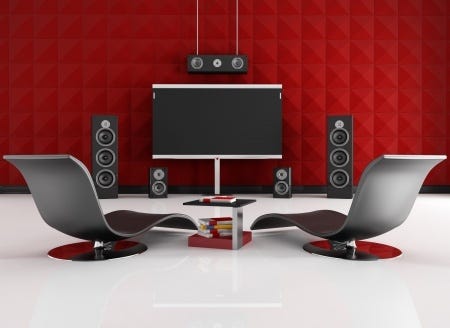1. Choosing the right room If you have purpose built a room, you are more likely to have created a room with good acoustics. If you are converting or multi-using another room in your home there are a few things you can do to make it more suitable. A room full of hard surfaces such as wood or tiled floors, large exposed glass panes, wooden furniture and higher ceilings will reflect a lot of sound, whereas a room with carpet, drapes, fabric couches and lower ceilings will automatically create a better listening room. Check out our blog on Acoustic Treatment for tips on achieving better acoustics
2. Positioning your Speakers By spending a
bit more time adjusting the placement of your speakers, you are certain to achieve a better result. The two front speakers and your head should create the perfect equilateral triangle, with the speakers facing toward you, and not directly forward out from the wall. All speakers should be at the same height, however if you have a tall speaker with several elements, then aim to have the tweeter level with your ears. Each speaker should have a clear space around it. Try to have at least 30 cm of space in all directions around each speaker so that the sound waves can travel without nearby surfaces causing reverberations. Sometimes this is not possible where speakers are mounted against a surface/wall, however it is still important to ensure other items such as lamps, bookcases etc do not interfere with the reflection of the soundwaves where possible. Move the speakers and sit in the place you will most commonly listen from. Don’t be afraid to do this many times, because you will soon start to hear when it sounds better.
3. Find the Best Listening Position: The Sweet Spot Although it is certain that a listening room will accommodate more than one person, there is always an ideal listening position, often called the “sweet spot” in every room. This is where your system sounds the best. Again, this is entirely personal as to how you like your system to sound, however it’s pretty easy to know where that spot is. Your “sweet spot” should be the third point of the triangle mentioned previously, relative to the front speakers.
4. Quality Speaker Cable Speaker cable comes in various qualities, so it is important to know that sound quality can be affected negatively by poor quality cable. Its job is to deliver adequate electrical current to your speakers. Categorised by gauge, you should avoid using inappropriate speaker cable that won’t deliver you the best possible result. The gauge of cable you should use is typically determined by the longest run required in your set up. Don’t spend hundreds or thousands on your set up and buy the “cheapest” cable because you think it’s behind the wall so it doesn’t matter. It does matter, and can make the difference between an ok result or a great result. Check out our blog on Speaker Cable here.
5. Adjust the Settings on Your Receiver Your receiver should have a menu that allows you to adjust many sound functions. They can include options which take into consideration the size of your speakers, bass output and speaker levels. These adjustments are important because you will be tailoring the frequency range, bass reproduction and volume sent from your receiver, which are best for your speakers capabilities. Some receivers even take out the guess work and include devices which can do this for you. Check out our blog on “Audyssey”. As always, taking the time to read the manual for your receiver will ensure you are aware of the features and capabilities you have available to you. Have fun with your set up, and remember that there are lots of things that you can do to improve your listening experience. We’d love to hear from you, and what you have done to get more out of your system. If you’d like some more advice, feel free to call one of our Selby Techs on 1800 69 2225












